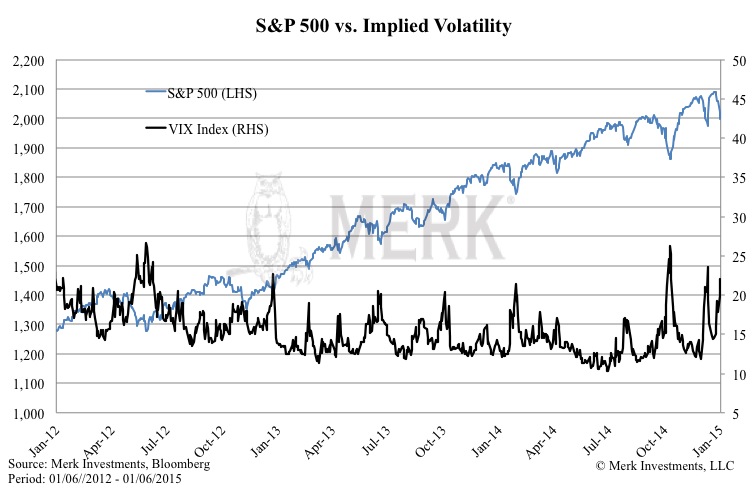Is Your Portfolio Ready for 2015? #crash?
Axel Merk, Merk Investments January 7, 2015 Is the recent bout in volatility yet another ‘buy-the-dip’ opportunity or a sign of worse to come? Investors struggle to both keeping up with the markets while protecting themselves against a severe correction. By taking a step back, investors might be able to see the forest for the trees to gauge whether their portfolio is ready for what lies ahead.
Risky assets are typically equities, but also junk bonds, MLP investments – just about anything that tends to do well when markets are “in a good mood” which often associated with low volatility. We have repeatedly cautioned in the past, that an uptick in volatility could derail these markets, i.e. as fear comes back, asset prices may be re-priced lower. In recent years, however, whenever volatility ticked up, it’s been a “buying opportunity.” As this bonanza has continued for so long, anyone taking a more defensive position than the market has quite likely under-performed. Our experience suggests that many investors don’t mind losing more than the market in a downturn, but they can’t bear the idea of not keeping up in a bull market. Investors can listen to pundits who preach the markets will always go up; or reconsider what diversification was supposed to be all about. You may want to do some soul searching whether you are comfortable with the risk profile of your portfolio. Most notably, are you comfortable with the risk profile of your portfolio should volatility move higher? How would your overall portfolio react if the stock market tumbled 25%? You don’t think it can happen? In 2013, the S&P was up over 30%; what can go up can also go down. Could you stomach a major correction? Protecting gains Downside protection Another form of protection could be achieved by buying put options; counterparty risks are mitigated in options as they are cleared through exchanges. Just like flood insurance, the worst time to buy insurance is when one is in the middle of a flood. And even if one buys the insurance during a dry spell, there’s the periodic renewal, i.e. an uncertain future cost of the insurance. With regard to an investment portfolio, protection tends to get more expensive:
So it’s cheaper to protect against a 25% market correction over the next month than over the next year; it’s cheaper to protect against a 25% market correction than against a 10% correction; and it’s cheaper to buy protection when volatility (perceived risk) is low. If you put the numbers together, even in a low volatility environment, it can cost 4%-5% annually to protect an equity portfolio against a 15%-20% correction. Keep in mind that you ought to be happiest if this protection expires worthless. As equity markets have moved about 20% per annum in recent years, you might be willing to give up a quarter of the gain. But history shows that 20% annual gains for the S&P are not normal. Are you really willing to give up 5% of your return if the S&P returns only 6% a couple of years in a row? And are you willing to give up 5% per annum if the S&P has minor, but not catastrophic down years where you lose both on the S&P, as well as on the cost of the insurance? Did I mention that the cost of buying protection might move up considerably during more volatile periods? Paying for downside protection Not surprisingly, many that look at ways to protect their portfolio on the downside, start thinking about revenue sources to pay for it. Writing covered call options is sometimes cited, a strategy that may generate income in a sideways market. Let me emphasize that this is not investment advice, as it should be clear that such strategies should only be pursued if one either understands them well or has the guidance of an expert who does. There other possibilities – each coming with their own set of risks. For example, investors might want to consider a currency overlay as an alpha generating strategy to help pay for the protection. We may be able to offer a solution to family offices or institutional investors (please contact us if you like more information); however, for most individual investors this isn’t an option as they can’t simply whip up a currency overlay. Taking chips off the table
To dive more into this topic, as well as our 2015 outlook, please register to join us on Thursday, January 22, 2015, for our Merk Webinar. In the meantime, follow me on Twitter at twitter.com/AxelMerk for my most up-to-date thoughts on the dollar, currencies and gold. If you haven’t done so, also make sure you sign up for Merk Insights to receive analyses like this one straight to your mailbox. Axel Merk Axel Merk is President & CIO of Merk Investments  Follow @AxelMerk Tweet Follow @AxelMerk Tweet
|


